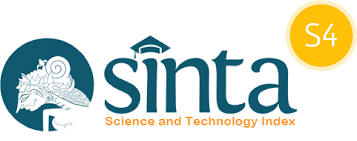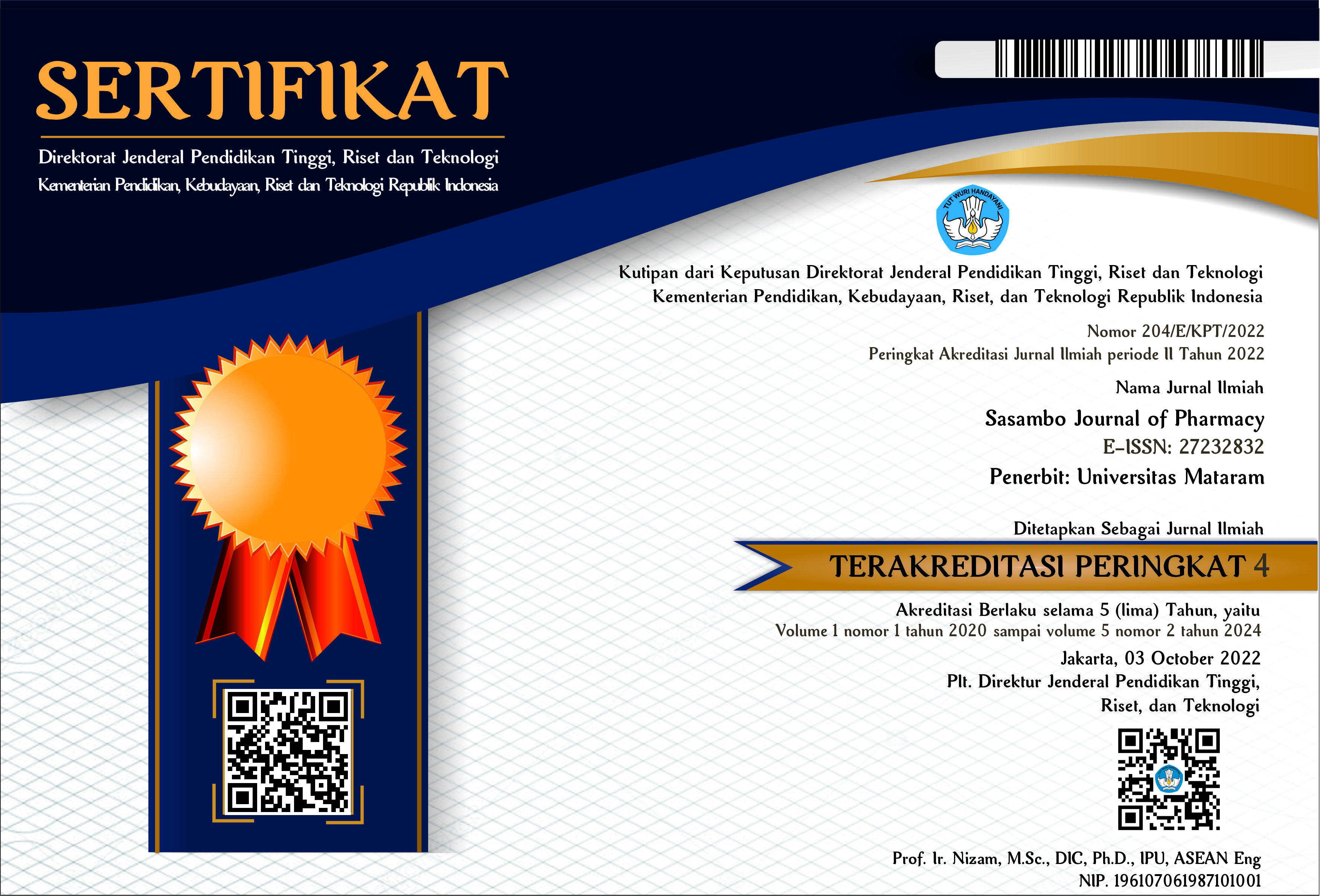Uji validitas dan reliabilitas instrumen kuesioner gambaran penggunaan obat nyeri haid secara mandiri pada mahasiswi Fakultas Kedokteran Universitas Mataram
DOI:
10.29303/sjp.v3i1.154Downloads
Abstract
Self-medication often becomes a choice for various complaints, one of which is menstrual pain. Regarding the description of the use of menstrual pain medication independently, it is still limited. The use of a questionnaire as a research instrument that has been tested for validity and reliability is very necessary. Therefore, this study aims to develop and test the validity and reliability of the description of the independent use of menstrual pain medication in female students. This research is a descriptive survey type with a cross-sectional design. The validity test was carried out using a qualitative and quantitative professional assessment method, namely by using the Content Validity Ratio (CVR). An advance validity test was conducted by 5 experts and 40 respondents. The reliability test was carried out with 40 respondents and used the Chronbach Alpha value. The results of the validity test obtained 28 questions with a CVR value of 1. Facial validity was declared valid after one repair. The reliability of the test obtained Cronbach's Alpha coefficient value of 0.934. Based on the validity and reliability test of the questionnaire, it was declared valid and reliable so that all questions could be used as an instrument to find out the description of the use of menstrual pain medication independently.
Keywords:
Menstrual pain, questionnaire, validation, reliabilityReferences
Almasdy, D., & Sharrif, A. (2011). Self-medication practice with nonprescription medication among university student: A review of the literature. Archives of Pharmacy Practice, 2(3), 95-100.
Amita, L. N. A., Budiana, I. N. G., Putra, I. W. A., & Surya, I. G. N. H. W. (2018). Karakteristik dismenore pada mahasiswi Program Studi Pendidikan Dokter angkatan 2015 di Fakultas Kedokteran Universitas Udayana. E-Jurnal Medika, 7(2), 1-10.
Bahri, A. A., Afriwandi., & Yusrawati. (2015). Hubungan antara kebiasaan olahraga dengan dismenore pada mahasiswi pre-klinik Program Studi Pendidikan Dokter Fakultas Kedokteran Universitas Andalas Tahun Ajaran 2012-2013. Jurnal Kesehatan Andalas, 4(3), 815-821.
Barriga, P. P., & Brantes, G. S. (2018). Normal menstrual cycle. IntechOpen, 1(1), 1-29.
Dipiro, J. T., Rotschafer, J. C., Kolesar, J. M., Malone, P. M., Schwinghammer, T. L., Wells. B. G., & Burns, M. A. C. (2008). Pharmacotherapy principles & practice, New York: McGraw-Hill Companies, Inc.
Giesen, D., Meertens, V., Visschers, R.V., & Beukenhorst, D. (2012). Questionnaire development. Heerlen: Statistics Netherlands.
Gunawan, A. A., & Sunardi, H. P. (2016). Pengaruh kompensasi dan disiplin kerja terhadap kinerja karyawan pada PT Gesit Nusa Tangguh. Jurnal Ilmiah Manajemen Bisnis, 16(1), 1-7.
Fitri, H. N., & Ariesthi, K. D. (2020). Pengaruh dismenore terhadap aktivitas belajar mahasiswi di Program Studi DIII Kebidanan. CHMK Midwifery Scientific Journal, 3(2), 159-64.
Hart, C. L., Ksir, C., Hebb, A. L. O., & Gilbert, R. W. (2019). Drugs, behaviour, and society third canadian edition. McGraw-Hill Education.
Helal, R. M., & Abou-ElWafa, H. S. (2017). Self-medication in university students from the City of Mansoura, Egypt. Journal of Environmental and Public Health, 2017(3), 1-7.
Hendryadi. (2017). Validitas isi: Tahap awal pengembangan kuesioner. Jurnal Riset Manajemen dan Bisnis (JRMB) Fakultas Ekonomi UNIAT, 2 (2), 169-178.
Heryanto, C. A. W., Korangkubu, C. S. F., Djeen, M. I. A., & Widayati. (2019). Pengembangan dan validasi kuesioner untuk mengukur penggunaan internet dan media sosial dalam pelayanan kefarmasian. Jurnal Farmasi Klinik Indonesia, 8(3), 175-187.
Jaiprakash, H., Myint, K. K., Chai, L. Y. W., & Nasir, B. M., (2016). Prevalence of dysmenorrhea and its sequel among medical students in a Malaysian University. British Journal of Medicine & Medical Research, 16(9), 1-8.
Lail, N. H. (2019). Hubungan status gizi, usia menarche dengan dismenorea pada remaja putri di SMK K Tahun 2017. Artikel Penelitian, 9(2), 88-95.
Larasati, T. A., & Alatas, F. (2016). Dismenore primer dan faktor risiko dismenore primer pada remaja. Majority, 5(3), 79-84.
Lestari, N. M. S. D. (2013). Pengaruh dismenorea pada remaja. Prosiding Seminar Nasional Fakultas Matematika dan Ilmu Pengetahuan Alam Universitas Pendidikan Ganesha III, 1(1), 323-9.
Lobo, R. A., Gershenson, D. M., Lentz, G. M., & Valea, F. A. (2017). Comprehensive Gynecology. 7th Edn. Philadelphia: Elsevier.
Putra, B. C., Musriha., & Noviandari, I. (2018). Pengaruh gaya kepemimpinan, budaya organisasi, dan komitmen organisasi terhadap kinerja karyawan di CV. Sinar Sejati Bojonegoro, 4(3), 52-61.
Pratama, I. S., Aini, S. R., Hidayat. L. H, Mursyid, M. H., & Muharromi, S. U. (2021). Pengembangan dan validasi kuesioner pengetahuan mahasiswa farmasi terkait produk kefarmasian serta alat kesehatan dalam pencegahan Covid-19. Jurnal Pijar Mipa, 16(2), 98-202.
Retnawati, H. (2017). Validitas dan reliabilitas konstruk skor tes kemampuan calon mahasiswa. Jurnal Ilmu Pendidikan, 23(2), 126-135.
Rusli, Y., Angelina, Y., & Hadiyanto. (2019). Hubungan tingkat stres dan intensitas dismenore pada mahasiswi di sebuah Fakultas Kedokteran di Jakarta. e-Journal Kedokteran Indonesia, 7(2), 122-126.
Smith, R. P. (2018). Dysmenorrhea and Menorrhagia. Cham: Springer International Publishing.
Taherdoost, H. (2016). Validity and reliability of the research instrument; How to test the validation of a questionnaire/survey in a research. International Journal of Academic Research in Management, 5(3), 28-36.
Waji, B. (2020). Gambaran Tingkat Pengetahuan Tentang Swamedikasi Nyeri Haid Primer Pada Mahasiswi Baru Di Universitas Islam Negeri Maulana Malik Ibrahim Malang. Universitas Islam Negeri Maulana Malik Ibrahim Malang. http://etheses.uin-malang.ac.id/22622/6/15670081.pdf.
Yesuf, T. A., Eshete, N. A., & Sisay, E. A. (2018). Dysmenorrhea among university health science students, Northern Ethiopia: Impact and associated factors. International Journal of Reproductive Medicine, 2018(1), 1-5. https://doi.org/10.1155/2018/9730328.
Zafar, S. N., Syed, R., Waqar, S., Zubairi, A. J., & Vaqar, T. (2008). Self-medication amongst university students of Karachi: Prevalence, knowledge, and attitudes. Journal of Pakistan Medical Association, 58(4), 214-217.
Zamanzadeh, V., Ghahramanian, A., Rassouli, M., Abbaszadeh, A., Alavi-Majd, H. & Nikanfar, A. R. (2015). Design and implementation content validity study: Development of an instrument for measuring patient-centered communication. Journal of Caring Sciences, 4(2), 165–178. https://doi.org/10.15171/jcs.2015.01
License
Copyright (c) 2022 The Author(s)

This work is licensed under a Creative Commons Attribution 4.0 International License.
Authors who publish with Sasambo Journal of Pharmacy (SJP), agree to the following terms:
- Authors retain copyright and grant the journal right of first publication with the work simultaneously licensed under a Lisensi Creative Commons Atribusi 4.0 Internasional. This license allows authors to use all articles, data sets, graphics and appendices in data mining applications, search engines, web sites, blogs, and other platforms by providing an appropriate reference. The journal allows the author(s) to hold the copyright without restrictions and will retain publishing rights without restrictions.
- Authors are able to enter into separate, additional contractual arrangements for the non-exclusive distribution of the journal's published version of the work (e.g., post it to an institutional repository or publish it in a book), with an acknowledgment of its initial publication in Sasambo Journal of Pharmacy
- Authors are permitted and encouraged to post their work online (e.g., in institutional repositories or on their website) prior to and during the submission process, as it can lead to productive exchanges, as well as earlier and greater citation of published work (See The Effect of Open Access).







